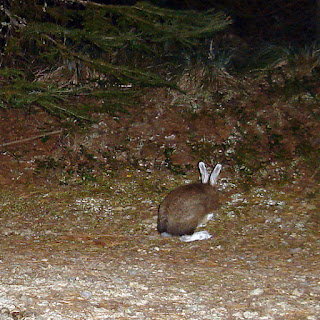Griffin Creek, Flathead County, Montana.
After a Montana breakfast (steak, eggs, and strong coffee), and a two-hour warm-up (sanding boards for Carl's log bath house), we are ready to hunt beaver on Griffin Creek.
Griffin Creek isn't at all like the tumbling streams of the Sierra Nevada.
There are no noisy boulder gardens, logjams, or water ouzels, but it is just as wild.
We launch the canoe.
The creek meanders quietly but flows strongly, and soon we find ourselves trapped in a channel 8 to 12 feet below a vast willow-choked floodplain.
Here and there you can wade the shallows to mid-calf, but then the bottom drops off into a dark 12-foot pool.
We are two contented codgers, adrift in the current, basking in the grand ambience of wild Montana.
Carl fly fishes aft; I play with my new GoPro Hero2 at the stern.
This is cool. I feel like a frontiersmen.
Apparently Carl is on the same wavelength.
"Did I tell you a grizzly visits this area?"
"Oh, really?" says I.
I have a hunch where this is going. My friend is well-read in frontier history. I preempt his mischief.
"And didn't
Hugh Glass get nailed in a patch of willows just like this place?"
 |
The only shot of the beaver's tail was hazed
by moisture on the lens. |
"Yep", says Carl as he guides the canoe into a muddy beaver canal.
We paddle for 50 feet and belly to a stop in the mud.
"The dam is just ahead. We'll walk in, but don't run if you see a grizzly."
"Roight", says I with sarcastic British tone.
A minute later we are standing before a 4-foot beaver dam, deciding where to stake our cameras.

Carl settles for a set on the dam, and I decide on a set looking up the dam's spillway.
I am rummaging through my pack looking for a mount when Carl announces that he's finished.
"What, finished? I haven't even started."
In a few minutes I finish my set, and Carl kicks a few sticks out of the dam.
The spillway starts to gurgle. Raised in Montana, my friend knows a thing or two about beaver.
"That'll bring 'em in".
Such are my memories of wild Montana.
A day later the redhead, Fred, and I headed home to California.
Carl agreed to leave the cams out for a month and to mail them to me before he heads for home back east.
He emailed me a couple weeks later.
"Pulled the beaver cams today. I was going to check on them and pull mine if the batteries were dead - which they were - but on the way in I saw human boot prints in the mud and got a little concerned so pulled both cameras. . . .
"Wanna hear the good news? I'm sure you do! The old master once again blew away the student. You got dozens of good shots of Mr. Beaver going up and down the dam - some real close. I got a few lousy photos of beaver far off on the other side of the dam, then 200+ photos of waving grass and trees. Grrrrrrr!"
Wish I could take the credit, but Carl was just too trusting of his trail camera's
PIR sensor.
Those motion detectors are suckers for hot air, and they've tricked me too many times. I set my cams for 24 hour detection only in cold weather or when the camera is in full shade.
Plus, I have a long way to go to match the beaver pictures taken by my fellow camera trappers on
Camtrapper.com.
But the best part of camera trapping isn't always the pictures.





















